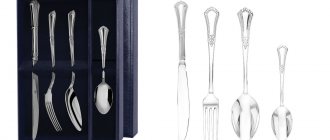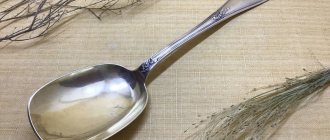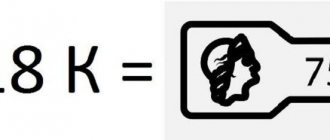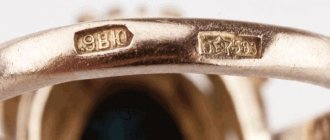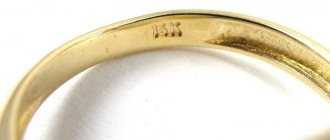Silver is the cheapest metal among those that have the right to be called precious. Silver jewelry can look elegant and noble, but be accessible to a wide range of consumers.
The situation with silverware is fundamentally different: it is not cheap, therefore a set of cutlery made from noble argentum is not available to every family. The explanation is simple: a lot of metal goes into making silver knives, spoons and forks, and production costs need to be recouped somehow.
The silverware's fineness, appearance, brand and history have a major impact on pricing. Let’s leave subjective characteristics aside and turn to the specifics, that is, the treasured numbers indicating the silver standard, and their immediate surroundings.
What are the hallmarks of silverware?
Silver is a soft metal, so its use in its pure form is limited only to the technical field and the production of measuring ingots.
In everyday life, we come across silver-based jewelry alloys: they are used to make jewelry, accessories, interior decor items and, of course, silverware.
To obtain an alloy with decent strength characteristics, so-called alloys, that is, jewelry alloys, are added to silver.
Moon metal's best friends are copper and nickel, but other additives are sometimes used. A large amount of copper determines the light yellowish tint inherent in silver “with history.”
The hallmark on cutlery is usually marked on the bottom of the handle, but variations are possible (especially on antique items). At the moment, on Russian products it reflects the content of precious metal per gram of jewelry alloy according to the generally accepted SI system. For example, 925 standard means that a kilogram of alloy contains 925 grams of silver (92.5%) - everything is simple and clear.
In Tsarist Russia, a different system of measures was adopted, the spool system, so on antique silverware you will see not three-, but two-digit numbers. The most common type is 84 sterling silver. This figure corresponds to the modern 875 sample.
By the way, almost all table silver of the Soviet era was produced from 875 alloy. Few could afford it, but the quality of these products was impeccable. Wealthy people, high-ranking officials and foreigners bought it with pleasure.
How does silverware differ from jewelry?
Table silver differs from jewelry only in the scope of application: similar alloys are used. Another thing is that for jewelry needs, high-grade alloys are more often used, while table silver can bear a mark with a modest number “800”.
The optimal jewelry alloy is the so-called “sterling silver”, 925 standard. It is used in the production of the vast majority of jewelry. But exclusive jewelry can also be of a higher standard, for example, with the “960” stamp.
The use of 925 silver in the production of cutlery is limited for obvious reasons. This alloy is quite soft, which promotes abrasion and deformation of products during operation. A fork with easily bending tines, you will agree, is not very convenient.
Cutlery set 4 pieces (go to SUNLIGHT catalog)
Nevertheless, the fairly soft 916 alloy is used to make very expensive tableware (decanters, glasses, shot glasses) and table decor items, usually with enameling. And 960 sterling silver is used exclusively for the manufacture of unique products with pronounced antiseptic properties.
However, with the advent of rhodium plating technology, the use of sterling silver in a not very familiar area has become more frequent. Now high-quality forks, spoons and knives are coated with a layer of rhodium by galvanization.
As a result of this treatment, the surface of silverware becomes more shiny, durable, and resistant to physical and chemical influences. And caring for rhodium-plated silverware is immeasurably easier.
Silver is a natural antiseptic that kills bacteria. However, rhodium plating, unfortunately, neutralizes its antiseptic properties. So if you want to feed your child with a silver spoon, it is better to choose untreated metal with the highest possible purity.
How to distinguish silver from other metals
Unlike gold, whose yellowish sheen is difficult to confuse with anything else, silver resembles many base metals. Therefore, it is important to know how to visually distinguish white gold from silver, platinum or tin, so as not to mistakenly purchase a penny trinket.
Silver jewelry has a grayish tint
The first thing you need to pay attention to if you need to distinguish silver from platinum is the size of the jewelry. Platinum is too expensive a metal to make massive rings or earrings from. Another sign is color. Silver jewelry has a grayish tint, while platinum jewelry is much lighter and has a white cast.
White gold is also easy to distinguish from silver. Silver, as mentioned above, has a gray tint, while white gold turns more yellow. In addition, silver items will be much less shiny than white gold items.
Tin is not very different from silver, so identifying the metal by eye in this case will not be easy. However, you can use the above method with iodine - if after applying the solution the metal turns black, then you have tin.
You can distinguish silver from palladium using nitric acid - it can be bought at a pharmacy or a specialized online store. Be careful and be sure to use gloves when working with acid! If you drop the substance onto silver jewelry, it will leave a dark mark. And if it's palladium, it will turn red.
How to check silver at home for authenticity (video)
What do the silver marks on spoons mean?
Silver is an inexpensive, but still noble metal. This means that it is subject to mandatory branding. For silver in Russia, a stamp in the shape of a lying barrel is accepted. In addition to the number indicating the content of precious metal, there is a female profile wearing a traditional Russian kokoshnik.
In addition to the mandatory hallmark, other marks may be affixed to the metal. Usually these are logos of manufacturers, brands, brands.
It is extremely difficult to understand all this diversity, and even more so if we are talking about antiques. The best option in this case is to submit the product for professional examination. The expert will indicate not only the precious metal content, weight and origin of the product, but also its estimated value.
You can, of course, experiment with homemade methods of determining the precious metal (iodine, lapis pencil, sulfur ointment and others like them), but no one can guarantee an accurate result. And there is also the risk of spoiling a valuable item: what if you received a spoon made at the Savva Morozov manufactory especially for the royal family?
Silverware produced in other countries bears the mark accepted in the country of origin. And in the Soviet Union, products made from precious metals were, as expected, decorated with a five-pointed star with a coat of arms in the center.
History of the Assay System
Not only numbers are used by the assay system, but also letters. If previously the sample carried more detailed information: the value of the item, the name of the jewelry maker and even the date of manufacture, now branding occurs strictly according to a system table. In Rus' this art has been studied for a long time. Only the master himself or his chief assistant could set samples. At the beginning of the 19th century, the Russian emperor even issued a decree that special chambers should be equipped for hallmarking silver and other metals.
The marking system has evolved, and along with it, the print itself will periodically change. There was one for each category of precious metals. The first print was in the form of a woman’s head in a kokoshnik, but each individual district in the Russian Empire had its own mark, on which letters were printed. They were the initials of the head of the district. Then it was decided to put an abbreviation according to the regions. At that time in Russia there were many German craftsmen who made their products from silverware with personalized names.
A unified testing system appeared under Peter the Great, in 1899. It was he who obliged the craftsmen to indicate the sample on the precious metal so that they could roughly determine the value of the item. An interesting fact is that on the first print the woman’s profile was turned to the left, and the mark itself was a primitive design. When high-quality fakes of the sample began to appear, it was decided to complicate the mark and in the final version, people saw the woman’s face, already turned to the right. In addition to this change, the craftsmen added additional touches to the image so that fraudsters could not fake it without special skills and equipment.
On a note! After approval of the new brand, each district additionally put down the letter abbreviation of its district.
Markings on silver spoons
Silver markings vary from manufacturer to manufacturer, but an hallmark is required. However, confusion may arise: for example, in the old days, the hallmark was set not only on silver, but also on silver-plated products.
And there are simply too many alloys similar to silver to count! If products made from them were produced in the Soviet Union or Russia, they will also be stamped (of course, without the coveted numbers):
- AL – aluminum;
- MELCH – cupronickel, an alloy of copper and nickel;
- MNC – nickel silver, copper and nickel plus zinc;
- MN – monel, cupronickel with a high nickel content;
- STAINLESS – “stainless steel”, that is, stainless steel.
Naturally, such cutlery is not silver and does not represent much value.
Principles of branding
The mark can be located inside or outside the product. The very first and most popular method is mechanical. Every jewelry maker should have this art. At first, an ordinary hammer was used for this, and then a special mechanism was made that carried out the process automatically. There were also special anvils, without which it was almost impossible to accurately apply a jewelry stamp. The machines had already been introduced when mass branding was required.
The electric spark method is carried out with the participation of electrodes
The electric spark method is carried out with the participation of electrodes. For this purpose, a special installation was made, with the help of which the print is burned out with a spark. If the brand has jumpers at the top between the outline and the badge, it means that this item was branded using the electric spark method. This method is more effective, but not all jewelry workshops and factories use it, because such an installation costs a lot of money.
For very expensive jewelry, a special laser can be used, which applies the mark very carefully. This method is not as relevant in mass production because the laser mark disappears over time. If a person has purchased such a product, then he needs to treat it more carefully, because after a while the mark will simply disappear and it will no longer be possible to confirm that the jewelry belongs to the precious right.
IMPORTANT! It is not so difficult to fake a sample, but the master will immediately understand that it is not real. In Soviet times, it was precisely because of the work of scammers that the prints changed several times. Most often, counterfeit items were found in silver dishes.
Famous world manufacturers of silverware
Antique silver is the most valued item: its value increases every year. Rare silver from famous manufacturers of the past has the highest cultural and historical value and is sold mainly in antique stores or at auctions.
Nevertheless, even now you can buy luxurious silverware from both Russian (Veliky Ustyug, the famous Argenta, Kostroma Jewelry Factory) and foreign (British Royal Buckingham, German Robbe & Berking and Koch & Bergfeld) manufacturers. Yes, it’s not cheap, but it’s a smart investment: luxury silverware will only become more expensive from year to year!
18.08.21
What does the marking mean?
Typically, the pure composition (999 fineness) of a noble metal (be it gold, silver) is not suitable for the production of a high-quality jewelry product. The objects obtained this way are too fragile.
In order to impart improved mechanical properties and create a more saturated shiny color texture, the composition is enriched by adding parts of non-ferrous metals - this is how alloys are obtained. Marking on a product made of precious metal (including silver) shows the content of precious metal in the alloy and serves to determine its fineness.&
Samples of precious metal alloys for jewelry and other silver items, including cutlery, are established by the legislation of the country. The earliest such standard is the “sterling silver” standard (925) - this is the material for the best silver devices: durable and safest for health (since only copper is added to the composition of 999 silver).
PHOTO CATALOG OF STAMPS OF GOLD AND SILVER MASTERS OF THE RUSSIAN EMPIRE
Beautiful cutlery has always been in demand, they were presented as a gift or simply bought for use in the household. Setting the table with gold or silver forks, spoons and knives is considered good manners, but not every housewife can afford such luxury. Many people purchase cupronickel silver cutlery or nickel silver items, which are difficult to distinguish from silver ones. Taking a closer look, you can see the MNC marking on the spoon - not every user knows what it is and how much such spoons cost. This article will help you understand the term; you should start with why cutlery is “branded” in general.
What does the marking mean?
Typically, the pure composition (999 fineness) of a noble metal (be it gold, silver) is not suitable for the production of a high-quality jewelry product. The objects obtained this way are too fragile. In order to impart improved mechanical properties and create a more saturated shiny color texture, the composition is enriched by adding parts of non-ferrous metals - this is how alloys are obtained. Marking on a product made of precious metal (including silver) shows the content of precious metal in the alloy and serves to determine its fineness.&
Samples of precious metal alloys for jewelry and other silver items, including cutlery, are established by the legislation of the country. The earliest such standard is the “sterling silver” standard (925) - this is the material for the best silver devices: durable and safest for health (since only copper is added to the composition of 999 silver).
What does MNC mean on cutlery?
Many people are interested in what the abbreviation MNC means, minted on tableware. Such a mark on a spoon or other device stands for copper-nickel-zinc. This alloy is called nickel silver. The use of zinc, in addition to the attractive appearance and practicality of the product, is characterized by a reduction in the cost of production. Translated from English, the name of this alloy means “new silver”.
Devices made of nickel silver in its pure form have an unpleasant metallic taste and smell. Therefore, they are coated with silver or gold plating with a thickness of at least 0.5 micrometers.
In accordance with GOST, the designation on sets of silverware is provided if the coating layer is at least:
Devices with gold or silver plating are an excellent gift for any person, regardless of age or gender, social status, or religion. Such gifts are given in the following cases:
- infant baptism;
- entering a university or obtaining a diploma;
- conclusion of a marriage;
- birth of the first child;
- silver or golden wedding anniversary;
- anniversaries and other celebrations.
It has long been believed that a donated silver spoon will bring:
- newlyweds - a long, happy life in love and harmony;
- students – successful mastery of science;
- babies - strong and healthy teeth.
Giving a fork as a gift was considered a bad sign, prophesying future misfortunes.
Marking of silver and silver-plated products
Some time ago I was faced with the need to understand the markings of Italian silver. And when I shared this information with my friend, who has long had a vintage store here at the Crafts Fair, she was surprised to learn that she also did not know all the intricacies of marking silver items. That’s why I decided – I need to write about it!
So, I am sharing useful information about marking silver products. Silver items in Italy are marked with the numbers 800, less often 925 (as a rule, 925 silver is used in jewelry). These numbers mean that every 1000 units of material consist of 800 (or 925) parts of silver and 200 (or 75) parts of copper. Pure silver is not used in the production of interior items, tableware and jewelry, as it is too soft. I will write about the evolution of the hallmark of Italian silver products a little lower.
Foreign, non-Italian silver items may have different markings. Thus, American silver is often marked Sterling, which is analogous to the 925 marking. English craftsmen use the “walking lion” symbol, which guarantees the 925 marking, and, in addition to this symbol, they put a mark with the date and city of manufacture, and older products have information about head of state. The rest of the European countries, except England, use the same labeling as Italy.
Not only silver items are marked. So, for example, I came across the mark of Alpacca, an alloy in composition very similar to cupronickel and nickel silver. None of these alloys, cupronickel, nickel silver and alpaca, contain silver, but alpaca makes a very good base for silver plating, and nickel silver cutlery is almost always plated with a thin layer of silver to remove the metallic taste. Some English and American items are marked German Silver, which means nickel silver. The Sheffield mark is also not silver, but old Sheffield pieces are always very high quality and therefore have a high value.
I would like to draw your attention to the Arg.800 and Arg.1000 markings used by Italian craftsmen. This marking means that the product is not silver, but silver-plated, that is, a thin silver layer is applied to the surface of the alloy, most often by galvanic method.
Well, a little more about the evolution of the silver hallmark in Italy. Italian craftsmen were required to use a single mark by law of May 2, 1872. A woman's head was used as a brand. The head with the number 1 was an analogue of 950, with the number 2 - 900, and without the number - 800.
From 1890 to 1934, markings were only numbers, without an oval, often in parallel with the symbols previously used by the jeweler, such as a flower.
With the advent of fascism in 1934, another mark was added to identify jewelers. The 800 marking was now located inside an oval, and they also began to use a hexagon containing the manufacturer's identification number, the littorio (symbol of fascism) and the initials - the abbreviation of the province in which the object was made.
With the end of the Fascist period in 1944 and until 1968, the same marking 800 inside the oval and the hexagon containing the manufacturer's identification code with the initials of the province in which the object was made continued to be used, but the littorio ray disappeared in the hexagon.
Since 1968, the 800 or 925 marking has always been enclosed in an oval, but the shape of the hexagon has changed - a star appeared inside, then the manufacturer's number and, finally, an abbreviation of the initial letters of the province where the product was made. This marking is still in use today.
PS All labeling data was taken from Italian websites, as well as after consultation with specialists in vintage products and antiques. Unfortunately, I couldn’t attach photos: those available on the Internet are too small in size.
